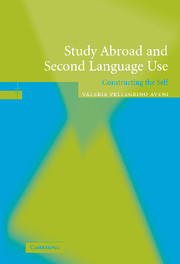Book contents
- Frontmatter
- Contents
- Acknowledgments
- Note on text conventions
- Abbreviations
- Introduction
- 1 Language use in a social context
- 2 The social dance: second language use and the construction of self
- 3 Learners and their environment: factors affecting self-construction
- 4 Coming into our own: the convergence of real self and ideal self
- Conclusion: The self in the second language: implications and next steps
- Appendix 1 Study context and research methodology
- Appendix 2 ACTR study-abroad program participants: 1995–1996 demographic profile
- Appendix 3 Participant profiles
- References
- Index
2 - The social dance: second language use and the construction of self
Published online by Cambridge University Press: 06 January 2010
- Frontmatter
- Contents
- Acknowledgments
- Note on text conventions
- Abbreviations
- Introduction
- 1 Language use in a social context
- 2 The social dance: second language use and the construction of self
- 3 Learners and their environment: factors affecting self-construction
- 4 Coming into our own: the convergence of real self and ideal self
- Conclusion: The self in the second language: implications and next steps
- Appendix 1 Study context and research methodology
- Appendix 2 ACTR study-abroad program participants: 1995–1996 demographic profile
- Appendix 3 Participant profiles
- References
- Index
Summary
I need to have the feeling I'm in control of my life to feel secure.
But here I feel like a child.
I mean I barely have control over what I eat, let alone anything else.
Jill, Fall SemesterThose who feel they are making fools of themselves and that they are exploiting their native speaker friends in an unacceptable way, may feel relieved of the bad conscience, at least partly, if they are told that this is not just their individual dilemma: in order to be a wit in a foreign language you have to go through the stage of being a half-wit – there is no other way.
Peter Harder, “Discourse as Self-Expression – on the Reduced Personality of the Second-Language Learner.”Everyone crowded around the table as the guests crammed into the small Russian apartment. Jill had wanted to speak with Assya, a young Russian woman about her own age. It was a dinner party, and several American and Russian girls were enjoying themselves, discussing classes, men, and their families back home. Jill chatted along with the others, making friends, sharing information, and practicing the language she had come to study – generally feeling good about the evening. Suddenly, the party took a decidedly different turn for Jill:
I began to zone out and Assya asks me where I live and how long I've been studying Russian. Well, I wasn't really paying attention and I thought she asked me how long I'd lived in Washington.[…]
- Type
- Chapter
- Information
- Study Abroad and Second Language UseConstructing the Self, pp. 34 - 53Publisher: Cambridge University PressPrint publication year: 2005

